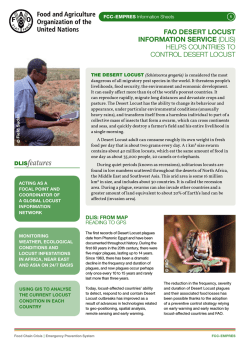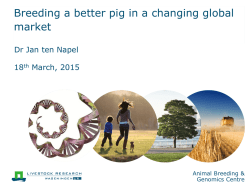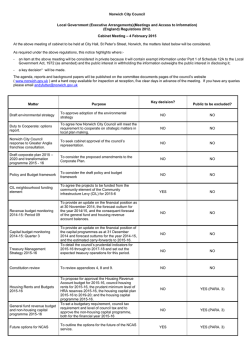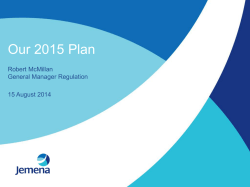
Download PDF
warning level: CAUTION DESERT LOCUST BULLETIN FAO Emergency Centre for Locust Operations General Situation during January 2015 Forecast until mid-March 2015 Desert Locust infestations increased during January along both sides of the Red Sea as a result of a second generation of winter breeding. Control operations intensified against numerous small hopper bands that formed in Sudan, Eritrea and Saudi Arabia. Although there were signs the situation was improving, there remains a moderate risk that any locusts that escape detection or control could form adult groups and a few small swarms that may eventually move to the Eritrean Highlands and the interior of northern Sudan and Saudi Arabia. If locusts reach the interior of Saudi Arabia and the Nile Valley in northern Sudan, breeding could commence by the end of the forecast period. Elsewhere, the situation remained calm and no significant developments are expected. Western Region. The situation remained calm in January. No locusts were reported in the region except for a few isolated solitarious adults south of the Atlas Mountains in Morocco. During the forecast period, low numbers of adults are likely to start to appear in the spring breeding areas south of the Atlas Mountains in Morocco and Algeria, and in southwest Libya. Small-scale breeding is expected to occur once temperatures warm up and if rains fall. Central Region. A second generation of breeding in Sudan and Eritrea caused locust numbers to increase along the Red Sea coast where numerous hopper bands formed. Control operations continued in both The FAO Desert Locust Bulletin is issued every month by the Desert Locust Information Service, AGP Division (Rome, Italy). It is supplemented by Alerts and Updates during periods of increased Desert Locust activity. All products are distributed by e-mail and are available on the Internet. Telephone: +39 06 570 52420 (7 days/week, 24 hr) Facsimile: +39 06 570 55271 E-mail: [email protected] Internet: www.fao.org/ag/locusts Facebook: www.facebook.com/faolocust Twitter: twitter.com/faolocust No. 436 (2.2.2015) countries. By the end of the month, there were signs that the situation was improving as vegetation dried out and many of the infestations had been treated. Locust numbers also increased in Saudi Arabia where hatching and band formation occurred on the Red Sea coast. Aerial and ground control operations were underway in all areas. Scattered adults were present on the Red Sea and Gulf of Aden coasts in Yemen. During the forecast period, small groups and a few swarms could form on the Red Sea coast of Eritrea, Sudan and Saudi Arabia. Once vegetation dries out, they could move into the Eritrean highlands, the Nile Valley in northern Sudan, and the spring breeding areas in the interior of Saudi Arabia. Eastern Region. The situation remained calm and no locusts were reported during January. Light rain continued to fall in the Jaz Murian Basin of southeast Iran that will allow ecological conditions to be favourable for small-scale breeding during the spring. No. 436 DESERT LOCUST BULLETIN Weather & Ecological Conditions in January 2015 Although only light rain fell at times, conditions remained favourable for breeding along both sides of the Red Sea coast. Showers fell for a second consecutive month in the interior of southeast Iran. In the Western Region, light rain fell at times during January. In Mauritania, light rain fell over western, central and northern parts of the country, affecting parts of Tiris-Zemmour, Adrar, Inchiri and Tagant. Breeding conditions became favourable in the north near Bir Moghrein from December rains. In northern Mali, light rains may have fallen in the northwest near Taoudenni. In Niger, light rain fell in the Ténéré Desert northwest of Fachi. Ecological conditions remained favourable for locust survival in a few places in the Adrar des Iforas and Timetrine of northern Mali and in the Air Mountains of Niger. In Northwest Africa, light rains may have fallen at times in parts of central and southern Algeria as well as south of the Atlas Mountains in Morocco and in northern areas of Western Sahara. Vegetation was becoming green in the Ziz-Ghris Valley on the southern side of the Atlas Mountains in Morocco and in adjacent areas of W. Daoura and Kem Kem in Algeria. In the Central Region, very little rain fell in the winter breeding areas along both sides of the Red Sea during January. In Sudan, breeding conditions remained favourable but vegetation started to dry out by the end of the month in the absence of rainfall. In Eritrea, showers may have fallen over parts of the coast early in the month. Although breeding conditions remained favourable, satellite imagery indicated that vegetation was starting to dry out. In Saudi Arabia, favourable conditions persisted along the Red Sea coast. In Yemen, light showers fell at times on the Tihama and Gulf of Aden coastal plains. Vegetation was drying out on the Red Sea coastal plains but remained green in a few areas northwest of Aden. In Oman, rain fell at times near the central coast but vegetation remained mostly dry. No rain fell in the Horn of Africa where dry conditions continued to prevail. page 2 of 8 In the Eastern Region, light showers fell in the interior of southeast Iran, including the Jaz Murian Basin for the third consecutive month. Consequently, ecological conditions are likely to improve once temperatures warm up. Elsewhere, dry conditions prevailed in the region. Area Treated Eritrea Saudi Arabia Sudan 10,247 ha (1-27 January) 7,958 ha (January) 22,676 ha (January) Desert Locust Situation and Forecast ( see also the summary on page 1 ) WESTERN REGION Mauritania • SITUATION No locusts were seen during surveys carried out in the north between Zouerate (2244N/1221W) and Bir Moghrein (2510N/1135W) in January. • FORECAST Isolated locusts may be present in the Aguilal Faye area. No significant developments are likely. Mali • SITUATION Although surveys could not be carried out in January, local scouts indicated that mainly mature solitarious adults and some hoppers were present in the northern Adrar des Iforas near Aguelhoc (1927N/0052E) and in Timetrine. • FORECAST Low numbers of adults are likely to persist in parts of the Adrar des Iforas and Timetrine. Niger • SITUATION No surveys were carried out and no locusts were reported during January. • FORECAST Isolated adults may be present in parts of the Air Mountains where they are likely to persist in areas that remain green. No significant developments are likely. Chad • SITUATION No surveys were carried out and no locusts were reported during January. • FORECAST No significant developments are likely. Senegal • SITUATION No reports were received during January. • FORECAST No significant developments are likely. Benin, Burkina Faso, Cameroon, Cape Verde, Côte d’Ivoire, Gambia, Ghana, Guinea, Guinea Bissau, Liberia, Nigeria, Sierra Leone and Togo • FORECAST No significant developments are likely. Algeria • SITUATION No locusts were seen during surveys carried out in the central and southern Sahara in January. • FORECAST As temperatures warm up in the central and southern Sahara, low numbers of adults could appear and breed on a small scale in any areas that receive rainfall. Morocco • SITUATION During January, isolated solitarious adults were maturing at two places south of the Atlas Mountains in W. Draa between Assa (2836N/0926W) and Zag (2800N/0920W) at the end of the month. • FORECAST Low numbers of adults may appear south of the Atlas Mountains in the Draa and Ziz-Ghris valleys as temperatures warm up and eventually breed on a small scale if rainfall occurs. Libya • SITUATION No surveys were carried out and no locusts were reported during January. • FORECAST Low numbers of adults may appear in the southwest as temperatures warm up and breed on a small scale if rainfall occurs. Tunisia • SITUATION No surveys were carried out and no locusts were reported during January. • FORECAST No significant developments are likely. CENTRAL REGION Sudan • SITUATION During the first week of January, several swarms continued to lay eggs on the southern coast between Aqiq (1813/N3811E) and Karora (1745N/3820E) as well as on the southern edge of the Tokar Delta. This was supplemented by reports of late instar hopper bands and mature swarms crossing the Eritrean border. Hatching and band formation continued throughout the month in most coastal areas extending from nearly Oseif (2146N/3651E) in the north to the Eritrean border in the south. The situation began to improve after mid-month. Control operations intensified in January, treating 22,676 ha of which 14,520 ha were by air. Elsewhere, a few scattered mature adults were seen in the northeast in Wadi Diib north of Tomala (2002N/3551E). • FORECAST Any adults that are not detected or controlled may form a few small groups or swarms, especially as vegetation dries out on the Red Sea coast. This may be supplemented by immature groups and a few small swarms from Eritrea. There is a moderate risk that these populations will move inland to the Nile Valley in River Nile and Northern States, mature and eventually lay eggs. Eritrea • SITUATION During January, locust numbers increased in central coastal areas near Sheib (1551N/3903E) and Embere (1628N/3856E), and on the northern coast near Karora (1745N/3820E) as a result of secondgeneration breeding. Hatching started during the first week and continued throughout the month, causing numerous small hopper bands to form. Scattered immature adults and small groups were also present. Control teams treated 10,247 ha from 1-27 January, mostly during the first decade of the month. • FORECAST Hopper groups and bands will fledge throughout February, causing an increasing number of adult groups and probably a few small swarms to form. Most of the fledging should finish by the end of February. Locusts are likely to remain on the coast until vegetation starts to dry out when they could move into the highlands or perhaps north along the coast to Sudan once vegetation dries out. No. 436 DESERT LOCUST BULLETIN page 3 of 8 No. 436 DESERT LOCUST BULLETIN Ethiopia • SITUATION During January, no locusts were seen during surveys carried out in parts of the northern regions of Afar and Amhara and in the eastern region of Somali. • FORECAST No significant developments are likely. Djibouti • SITUATION No reports were received during January. • FORECAST No significant developments are likely. Somalia • SITUATION No surveys were carried out and no locusts were reported during January. • FORECAST Unless further rainfall occurs, no significant developments are likely. Egypt • SITUATION During January, isolated fourth instar solitarious hoppers were reported at one location near the Red Sea coast to the west of Berenice (2359N/3524E). No locusts were seen elsewhere on the Red Sea coast or in subcoastal areas of the southeast. • FORECAST Locust numbers will continue to decline on the southern coastal plains of the Red Sea as vegetation dries out. Saudi Arabia • SITUATION During the first week of January, a mature swarm and a few adult groups laid eggs on the northern coast between Yenbo (2405N/3802E) and Umm Lajj (2501N/3716E). Hatching and band formation occurred on the central coast during the first two decades near Qunfidah (1909N/4107E), Lith (2008N/4016E), south of Jeddah, and between Mecca (2125N/3949E) and Thuwal (2215N/3906E). Fledging commenced during the last week of January. Control operations treated 7,958 ha of which 300 ha were by air. page 4 of 8 • FORECAST Limited hatching and band formation is likely to occur on the northern coast near Yenbo. Elsewhere, any adults that escape detection or control are likely to form small groups and perhaps a few small swarms that will move to spring breeding areas in the interior. Unless further rainfall occurs, another generation of breeding is not expected on the Red Sea coastal plains. Yemen • SITUATION During January, scattered immature and mature solitarious adults were present on the northern Red Sea coastal plains between Al Zuhrah (1541N/4300E) and Midi (1619N/4248E) and on the central coast east of Hodeidah (1450N/4258E). Similar populations were also present on the Gulf of Aden coastal plains northwest of Aden (1250N/4503E) and east of Zinjibar (1306N/4523E). • FORECAST Small-scale breeding is likely to continue along parts of the Gulf of Aden coastal plains, causing locust numbers to increase slightly. Breeding is less likely on the Red Sea coast unless further rainfall occurs. Oman • SITUATION During January, no locusts were seen during surveys on the northern Batinah coast, the Musandam Peninsula, in the northern interior regions of Dhahera, Dakhiliya and Sharqiya, and in the southern region of Dhofar. • FORECAST Low numbers of adults may appear in the spring breeding areas on the Batinah coast and perhaps on the central coast at the end of the forecast period. Bahrain, Iraq, Israel, Jordan, Kenya, Kuwait, Lebanon, Palestine, Qatar, Syria, Tanzania, Turkey, UAE and Uganda • FORECAST No significant developments are likely. EASTERN REGION Iran • SITUATION No locusts were seen during surveys carried out on the southeast coast near Jask (2540N/5746E) in January. • FORECAST Low numbers of adults are likely to appear on the southeast coast between Jask and Chabahar and in the Jaz Murian Basin of the interior during February. Once temperatures increase, small-scale breeding is expected to occur in areas of recent rainfall in Jaz Murian. Pakistan • SITUATION No surveys were carried out and no locusts were reported during January. • FORECAST Isolated adults may appear in coastal areas of Baluchistan and breed on a small scale in areas that receive rainfall. India • SITUATION No locusts were seen during surveys carried out in Rajasthan during January. • FORECAST No significant developments are likely. Afghanistan • SITUATION No reports received. • FORECAST No significant developments are likely. Announcements Desert Locust warning levels. A colour-coded scheme indicates the seriousness of the current Desert Locust situation: green for calm, yellow for caution, orange for threat and red for danger. The scheme is applied to the Locust Watch web page and to the monthly bulletin’s header. The levels indicate the perceived risk or threat of current Desert Locust infestations to crops and appropriate actions are suggested for each level. Locust reporting. During calm (green) periods, countries should report at least once/month and send RAMSES data with a brief interpretation. During caution (yellow), threat (orange) and danger (red) periods, often associated with locust outbreaks, upsurges and plagues, RAMSES output files with a brief interpretation should be sent at least twice/week within 48 hours of the latest survey. Affected countries are also encouraged to prepare decadal bulletins summarizing the situation. All information should be sent by e-mail to the FAO/ECLO Desert Locust Information Service ([email protected]). Information received by the end of the month will be included in the FAO Desert Locust Bulletin for the current month; otherwise, it will not appear until the following month. Reports should be sent even if no locusts were found or if no surveys were conducted. Locust tools and resources. FAO has developed a number of tools that National locust information officers and other interested individuals can use for Desert Locust early warning and management: • MODIS. Vegetation imagery every 16 days (http:// iridl.ldeo.columbia.edu/maproom/.Food_Security/. Locusts/.Regional/.MODIS/index.html) • MODIS. Daily rainfall imagery in real time (http:// iridl.ldeo.columbia.edu/maproom/.Food_Security/. Locusts/index.html) • RFE. Rainfall estimates every day, decade and month (http://iridl.ldeo.columbia.edu/maproom/. Food_Security/.Locusts/index.html) • Greenness maps. Dynamic maps of green vegetation evolution every decade (http://iridl. ldeo.columbia.edu/maproom/Food_Security/ Locusts/Regional/greenness.html) • eLocust3 training videos. A set of 15 introductory training videos are available on YouTube: https://www.youtube.com/playlist?list=P LjxRk5CAwvG_0iFxjZ5C2fLByF3jhvHOx • RAMSESv4 training videos. A set of basic training videos are available on YouTube: https:// www.youtube.com/playlist?list=PLjxRk5CAwvGPximOs9ICMxzZtYU93tvb • FAODLIS Google site. A platform for sharing problems, solutions, tips and files for eLocust2, eLocust2Mapper, RAMSES and remote sensing (https://sites.google.com/site/faodlis) • FAOLOCUST Twitter. The very latest updates are posted on Twitter (http://www.twitter.com/ faolocust) • FAOLocust Facebook. A social means of information exchange using Facebook (http:// www.facebook.com/faolocust) • Slideshare. Locust presentations and photos available for viewing and download (http://www. slideshare.net/faolocust) • eLERT. A dynamic and interactive online database of resources for locust emergencies (http://sites.google.com/site/elertsite) New information on Locust Watch. Recent additions to the web site (www.fao.org/ag/locusts) are: • Desert Locust situation updates. Archives • eLocust3. Activities – DLIS • RAMSESv4. Activities – DLIS • DLIS Locust Information Officer / Trainee. Activities – DLIS No. 436 DESERT LOCUST BULLETIN page 5 of 8 SMALL • swarm: 1 - 10 km2 No. 436 • band: 25 - 2,500 m2 MEDIUM • swarm: 10 - 100 km2 • band: 2,500 m2 - 10 ha LARGE DESERT LOCUST BULLETIN • swarm: 100 - 500 km2 • band: 10 - 50 ha VERY LARGE • swarm: 500+ km2 • SWAC 29th Session report. Publications – Reports • CRC 29th Session report. Publications – Reports • DLIS Information sheet. Information – FCC/ EMPRES • band: 50+ ha RAINFALL LIGHT • 1 - 20 mm of rainfall. MODERATE • 21 - 50 mm of rainfall. 2015 events. The following activities are scheduled or planned: • CRC. Regional contingency planning workshop, Hurghada, Egypt (15-19 February) • CRC/SWAC. 7th inter-regional workshop for Desert Locust Information Officers, Hurghada (2225 February) HEAVY • more than 50 mm of rainfall. OTHER REPORTING TERMS BREEDING • the process of reproduction from copulation to fledging. SUMMER RAINS AND BREEDING Jeremy Roffey (31 March 1932 – 7 January 2015). Mr. Roffey was an entomologist who worked for FAO as a locust officer in the 1960s and as Head of the Desert Locust Information Service for the Centre for Overseas Pest Research (UK) in the 1970s. He returned to FAO in 1979 initially as Reporting and Forecasting Officer, followed by Senior Locust Forecasting Officer in DLIS, and Senior Officer of the Locust Group until he retired in 1993. We would like to express our sincere condolences to his family and government. Glossary of terms • July - September/October WINTER RAINS AND BREEDING • October - January/February SPRING RAINS AND BREEDING • February - June/July DECLINE • a period characterised by breeding failure and/ or successful control leading to the dissociation of swarming populations and the onset of recessions; can be regional or major. OUTBREAK • a marked increase in locust numbers due to concentration, multiplication and gregarisation which, unless checked, can lead to the formation of hopper bands and swarms. UPSURGE The following special terms are used in the Desert Locust Bulletin when reporting locusts: • • • • NON-GREGARIOUS ADULTS AND HOPPERS ISOLATED (FEW) very few present and no mutual reaction occurring; 0 - 1 adult/400 m foot transect (or less than 25/ha). SCATTERED (SOME, LOW NUMBERS) enough present for mutual reaction to be possible but no ground or basking groups seen; 1 - 20 adults/400 m foot transect (or 25 - 500/ha). GROUP • forming ground or basking groups; • 20+ adults/400 m foot transect (or 500+/ha). ADULT SWARM AND HOPPER BAND SIZES VERY SMALL • swarm: less than 1 km2 page 6 of 8 • band: 1 - 25 m2 • a period following a recession marked initially by a very large increase in locust numbers and contemporaneous outbreaks followed by the production of two or more successive seasons of transient-to- gregarious breeding in complimentary seasonal breeding areas in the same or neighbouring Desert Locust regions. PLAGUE • a period of one or more years of widespread and heavy infestations, the majority of which occur as bands or swarms. A major plague exists when two or more regions are affected simultaneously. RECESSION • period without widespread and heavy infestations by swarms. REMISSION • period of deep recession marked by the complete absence of gregarious populations. WARNING LEVELS GREEN • Calm. No threat to crops. Maintain regular surveys and monitoring. YELLOW • Caution. Potential threat to crops. Increased vigilance is required; control operations may be needed. ORANGE • Threat. Threat to crops. Survey and control operations must be undertaken. RED • Danger. Significant threat to crops. Intensive survey and control operations must be undertaken. REGIONS WESTERN • locust-affected countries in West and North-West Africa: Algeria, Chad, Libya, Mali, Mauritania, Morocco, Niger, Senegal, Tunisia; during plagues only: Burkino Faso, Cape Verde, Gambia, Guinea and Guinea-Bissau. CENTRAL • locust-affected countries along the Red Sea: Djibouti, Egypt, Eritrea, Ethiopia, Oman, Saudi Arabia, Somalia, Sudan, Yemen; during plagues only: Bahrain, Iraq, Israel, Jordan, Kenya, Kuwait, Qatar, Syria, Tanzania, Turkey, UAE and Uganda. EASTERN • locust-affected countries in South-West Asia: Afghanistan, India, Iran and Pakistan. No. 436 DESERT LOCUST BULLETIN page 7 of 8 Desert Locust Summary Criquet pèlerin - Situation résumée 10W 40N 0 10E 20E 436 30E 40E 60E 50E 70E 30N L F M DB D D K D LD D D L DB DM DM D DM 20N LL LL L L C 10N SITUATION: FORECAST TO: PREVISION AU: 15.03.15 favourable breeding conditions conditions favourables à la reproduction major swarm(s) essaim(s) important(s) minor swarm(s) essaim(s) limité(s) non swarming adults adultes non essaimant LIKELY POSSIBLE PROBABLE POSSIBLE Jan 2015 jan 2015 immature adults adultes immatures mature or partly mature adults adultes matures ou partiellement matures adults, maturity unknown adultes, maturité inconnue egg laying or eggs pontes ou œufs hoppers larves hoppers & adults (combined symbol example) larves et adultes (exemple symboles combinés) adults / hoppers adultes / larves in density groups low/unknown essaims ou en bandes larvaires densité groupes faible/inconnue swarms or hopper bands
© Copyright 2025






